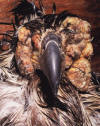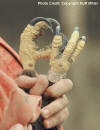| Avian Pox |
 |
|
| |
| Causative Agent |
-
A disease of the skin of birds caused by infection with the
Avipoxvirus group of
viruses.
|
| Images |
|
Click on images to enlarge. |
 |
 |
 |
|
Avian pox lesions are
typically found on the featherless regions of the body. As the
disease progresses, pox lesions become more extensive,
potentially impairing sight, breathing and feeding, such as in
this immature bald eagle. |
Suspected avian pox in a
young-of-the-year bald eagle. A nostril has been completely
occluded with a pox-like lesion. The legs and feet of the same
eagle show lesions characteristic of avian pox. |
|
| Distribution |
|
Geographic: |
-
Avian pox has been reported worldwide.
-
Avian pox is usually considered an
endemic disease in birds. Because
of increased frequency of reported cases involving new
species, it is also viewed as an
emerging disease.
-
Mosquitoes and birds acting
as
carriers can spread the disease at
bird feeders and through migratory flyways.
|
|
Seasonality: |
-
Infection with avian pox can occur throughout the year.
-
Environmental factors, the activity of mosquitoes, and the habits of the
species affected by avian pox can influence when outbreaks
occur.
|
|
| Hosts, Transmission and Life
Cycle |
| Hosts: |
-
Avian pox has been reported in approximately 60 species of free-living
birds.
-
It is most commonly reported in songbirds, upland game birds, marine
birds and birds of prey.
|
|
Transmission and Life Cycle: |
-
The
virus stimulates the upper layers
of the skin to grow rapidly; this new tissue soon dies.
-
Avian pox can be acquired
through:
-
transfer from infected hosts via infected mouthparts of
mosquitoes;
-
direct contact with surfaces or air-borne particles
contaminated with poxvirus, resulting in infections when
the
virus enters through abraded skin
or though
mucous membranes.
-
Avian pox
virus can survive considerable
aridity (dryness); therefore, dust particles containing the
virus can remain infective for extended periods of time.
|
|
| Signs and Symptoms |
-
There are two forms of avian pox:
cutaneous (involving the skin) and
wet (involving internal
organs).
-
The cutaneous form is more
commonly reported in wild birds:
-
birds with wart-like
nodules on the featherless areas of
the body, including the feet and legs, margins of the eyes, and
base of the beak should be considered suspect cases of avian
pox;
-
birds may appear weak and
emaciated if the
nodules have interfered with
feeding;
-
labored breathing may be
observed in birds where air passages have been blocked;
-
birds can fully recover
provided they are able to feed. The disease usually is
self-limiting and leaves only minor scars;
-
growths can spread and
increase in size, forming clusters which may impair sight,
breathing and feeding;
-
secondary
bacterial and
fungal infections of pox lesions
are common with cutaneous forms of avian pox infection.
-
Wet avian pox is commonly
reported in domestic chickens and turkeys and less commonly in wild
birds, likely because it is less visible than the cutaneous form:
-
wet pox involves
lesions of the
mucous membranes of the mouth and upper digestive and respiratory tracts;
-
wet pox may contribute to mortality and sickness leading to the removal
of infected birds by predators and scavengers.
|
| Meat Edible? |
-
Meat from an infected animal is suitable for human consumption if the
affected parts are trimmed and discarded. Do not consume the lungs
or associated tissues.
|
| Human Health Concerns and
Risk Reduction |
-
There is no evidence that avian pox
virus can infect humans.
-
If birds
with suspected avian pox are handled and other live birds are to be
handled in the future, any surface that infected birds have come in
contact with should be cleaned with a 10% household bleach solution
to prevent the spread of the disease to other birds.
|
| Samples for Diagnosis |
-
A tentative diagnosis of avian pox can be made based on the appearance of
wart-like
lesions on the body; however, this
must be confirmed with microscopic examination and
virus isolation.
-
Submission of the whole bird
or affected body parts are needed for
virus isolation.
-
Specimens should be frozen
if held for more than a day before shipment to a diagnostic
laboratory.
|
| Further Reading |
|
|
|
|



